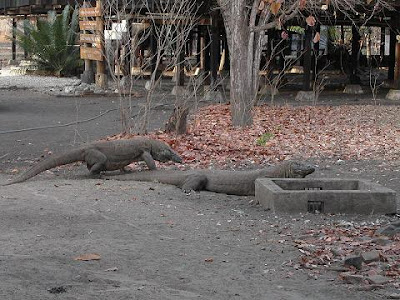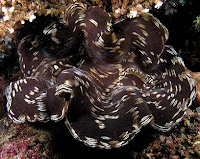The Komodo National Park is a national park in Indonesia located within the Lesser Sunda Islands in the border region between the provinces of East Nusa Tenggara and West Nusa Tenggara. The park includes the three larger islands Komodo, Padar and Rincah, and 26 smaller ones, with a total area of 1,733 km² or 603 km² of it land. The national park was founded in 1980 in order to protect the Komodo dragon, the world's largest lizard. Later it was dedicated to protecting other species, including marine species. In 1991 the national park was declared a UNESCO World Heritage Site. The details of Komodo National Park are explained in world tour guides below.
 The park comprises a coastal section of western Flores, the three larger islands of Komodo, Padar and Rincah, 26 smaller islands and the surrounding waters of the Sape Straights. The islands of the national park are of volcanic origin. The terrain is generally rugged, characterized by rounded hills, with altitudes up to 735 m. The climate is one of the driest of Indonesia with annual rainfall between 800mm and 1000mm. Mean daily temperatures in the dry season from May to October are around 40°C.
The park comprises a coastal section of western Flores, the three larger islands of Komodo, Padar and Rincah, 26 smaller islands and the surrounding waters of the Sape Straights. The islands of the national park are of volcanic origin. The terrain is generally rugged, characterized by rounded hills, with altitudes up to 735 m. The climate is one of the driest of Indonesia with annual rainfall between 800mm and 1000mm. Mean daily temperatures in the dry season from May to October are around 40°C.The hot and dry climate of the Park, characterized by savannah vegetation, make it to a good habitat for the endemic Komodo dragon or Varanus komodoensis. Their populations are restricted to the islands of Komodo is 1,700, Rinca is 1,300, Gili Motang is 100, Gili Dasami is 100, and Flores is ca. 2,000, while extinct on Padar. Cloud forests appear only in few areas above 500 metres but they provide habitat to several endemic flora. Coastal vegetaion includes mangrove forest, which generally appear in the sheltered bays of the three larger islands.
Fringing and patch coral reefs are extensive and best developed on the north-east coast of Komodo. The park is rich in marine life, including whale sharks, ocean sunfish, manta rays, eagle rays, pygmy seahorse, false pipefish, clown frogfish, nudibranchs, blue-ringed octopus, sponges, tunicates, and coral. The island of Padar and part of Rincah have been established as nature reserves in 1938. Komodo Island has been declared a nature reserve in 1965, and in 1977 an UNESCO biosphere reserve. The three islands have been declared a national park in 1980, which was later extended to include the surrounding marine area and a section of Flores in 1984. In 1991 the national park was declared a UNESCO World Heritage Site.
Since 1995, the national park authority has been supported by The Nature Conservancy or TNC, an American environmental organization. A new management plan was co-authored with TNC and implemented in 2000 to address the problem of increasing resource exploitation, both marine and terrestrial. Most pressure on marine resources originates from fishing communities and commercial enterprises from outside the park. However, regulations and restrictions on resource use impact mostly on park residents, who have few options to make a living but rely on what the park has to offer. The provision of alternative livelihoods is part of the overall management strategy, but communities within the park are yet to benefit from appropriate measures addressing their needs.

 Komodo National Park has been selected as one of 28 finalists to become one of the New7Wonders of Nature. About 4,000 people live within the park. Scuba diving is popular because of the park's high marine biodiversity. The development of, largely marine-based, ecotourism is the main strategy to make the park self-financing and generate sufficient revenue through entrance fees and tourism licenses to cover operational and managerial costs. To this end, a joint venture between TNC and a tourism operator were granted a tourism concession that also entails extensive park management rights. This concession has generated an ongoing controversy. The joint venture has been accused of making decisions behind closed doors, and many people in and around Komodo claim that they haven’t been consulted regarding decisions that ultimately affect their lives.
Komodo National Park has been selected as one of 28 finalists to become one of the New7Wonders of Nature. About 4,000 people live within the park. Scuba diving is popular because of the park's high marine biodiversity. The development of, largely marine-based, ecotourism is the main strategy to make the park self-financing and generate sufficient revenue through entrance fees and tourism licenses to cover operational and managerial costs. To this end, a joint venture between TNC and a tourism operator were granted a tourism concession that also entails extensive park management rights. This concession has generated an ongoing controversy. The joint venture has been accused of making decisions behind closed doors, and many people in and around Komodo claim that they haven’t been consulted regarding decisions that ultimately affect their lives.Most controversy, however, was caused by the death of several fishermen since the 1980s. The circumstances of the fishermen’s deaths are contested. While park patrol including, at the time, police and navy personnel claim they acted in self-defense, fishing communities accuse park management of having deliberately killed the fishermen.







No comments:
Post a Comment